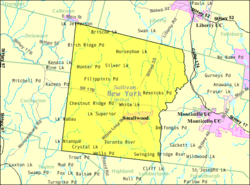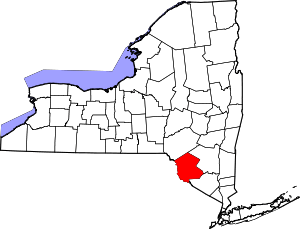Bethel, New York
Bethel is a town in Sullivan County, New York, United States. The population was estimated at 4,255 in 2010.[3]
- This is the article about the Sullivan County, New York town. For the Dutchess County, New York hamlet, see Bethel, Pine Plains
Bethel, New York | |
|---|---|
Town | |
| Motto(s): Home of the 1969 Original Woodstock Festival | |
 U.S. Census Map | |
 | |
| Coordinates: 41°41′27″N 74°50′30″W | |
| Country | United States |
| State | New York |
| County | Sullivan |
| Area | |
| • Total | 89.96 sq mi (232.99 km2) |
| • Land | 85.27 sq mi (220.84 km2) |
| • Water | 4.69 sq mi (12.15 km2) |
| Elevation | 1,322 ft (403 m) |
| Population (2010) | |
| • Total | 4,255 |
| • Estimate (2016)[2] | 4,110 |
| • Density | 48.20/sq mi (18.61/km2) |
| Time zone | UTC-5 (Eastern (EST)) |
| • Summer (DST) | UTC-4 (EDT) |
| ZIP code | 12720 |
| Area code(s) | 845 |
| FIPS code | 36-06310 |
| GNIS feature ID | 0978730 |
The town received worldwide fame after it became the host of the 1969 Woodstock Festival, which was originally planned for Wallkill, New York, but was relocated to Bethel after Wallkill withdrew.
History
The first settlers arrived circa 1795 near the present communities of Bethel and White Lake. The Town of Bethel was established in 1809 from the Town of Lumberland.
By the middle of the 19th century, a tourist industry began to grow. Bethel was home to numerous hotels that were part of the "Borscht Belt" and numerous sleepaway camps for most of the 20th century, including Camp Ma-Ho-Ge, Camp Chipinaw, and Camp Ranger – all on Silver Lake. In 1961, Son of Sam mass murderer David Berkowitz was a camper at a now defunct summer camp in Bethel. Berkowitz left the camp after a suspicious fire occurred in his cabin.
The Town of Bethel was brought to the world's attention in 1969, when nearly 500,000 people gathered at Max Yasgur's Farm for "Three Days of Peace and Music".[4] The documentary made about Woodstock released in 1970 showed interviews with numerous Bethel residents, including Art Vassmer, co-owner of Vassmers General Store in Kauneonga Lake. A movie called Taking Woodstock was released in August 2009 based on the book of the same title by Elliot Tiber, whose parents owned the nearby El Monaco Motel in White Lake and played a pivotal role in bringing the Woodstock nation to Bethel.
In 2006, Bethel Woods opened on the original Woodstock site as a state-of-the-art performing arts venue. In early 2008, a multi-media Woodstock "interpretive" museum opened near the old Yasgur's Farm to complement the concert space, which hosted the New York Philharmonic, Wynton Marsalis, Diane Reeves, Chris Botti, the Goo Goo Dolls, the Boston Pops Orchestra, and Crosby, Stills, Nash & Young in its inaugural season. Highlights of the Center's 2007 season were performances by Lynyrd Skynyrd/Marshall Tucker Band, Bob Dylan, Richie Havens/Arlo Guthrie, Earth, Wind & Fire, and repeat performances of the New York Philharmonic and the Boston Pops Orchestra. 2008's season featured The New York Philharmonic, the Boston Pops Orchestra, Steely Dan, the Allman Brothers, and sold-out performances by the Jonas Brothers and the last concert of the season, featuring Heart, Journey, and Cheap Trick. The 2009 season was headlined by Brad Paisley and his band "The Drama Kings".
Geography
According to the United States Census Bureau, the town has a total area of 90.0 square miles (233 km2), of which 85.4 square miles (221 km2) is land and 4.6 square miles (12 km2) (5.13%) is water. One of the most attractive features of Bethel is its access to numerous lakes, all within a five-minute drive of each other. They include White Lake, its northern portion known as Kauneonga Lake, Silver Lake, and Lake Superior, which is part of the state park with the same name.
The Town of Bethel, which is primarily rural in character, was part of the old Borscht Belt Catskills resort area. Although some bungalow colonies continue to exist, catering to a largely Orthodox Jewish clientele during the summer, most of the old resorts which had their heyday from the 1930s to the early 1970s have long since closed.
Demographics
| Historical population | |||
|---|---|---|---|
| Census | Pop. | %± | |
| 1820 | 1,096 | — | |
| 1830 | 1,203 | 9.8% | |
| 1840 | 1,483 | 23.3% | |
| 1850 | 2,087 | 40.7% | |
| 1860 | 2,854 | 36.8% | |
| 1870 | 2,736 | −4.1% | |
| 1880 | 2,562 | −6.4% | |
| 1890 | 2,158 | −15.8% | |
| 1900 | 2,248 | 4.2% | |
| 1910 | 2,164 | −3.7% | |
| 1920 | 1,849 | −14.6% | |
| 1930 | 1,799 | −2.7% | |
| 1940 | 2,321 | 29.0% | |
| 1950 | 2,351 | 1.3% | |
| 1960 | 2,366 | 0.6% | |
| 1970 | 2,763 | 16.8% | |
| 1980 | 3,335 | 20.7% | |
| 1990 | 3,693 | 10.7% | |
| 2000 | 4,362 | 18.1% | |
| 2010 | 4,255 | −2.5% | |
| Est. 2016 | 4,110 | [2] | −3.4% |
| U.S. Decennial Census[5] | |||
At the time of the census[6] of 2000, there were 4,362 people, 1,649 households, and 1,101 families residing in the town. The population density was 51.1 people per square mile (19.7/km2). There were 3,641 housing units at an average density of 42.6 per square mile (16.5/km2). The racial makeup of the town was 90.35% White, 4.61% African American, 0.18% Native American, 0.50% Asian, 0.16% Pacific Islander, 2.80% from other races, and 1.40% from two or more races. 11.28% Latin American or Latino of any race.
There were 1,649 households, out of which 27.1% had children under the age of 18 living with them, 54.2% were married couples living together, 7.9% had a female householder with no husband present, and 33.2% were non-families. 27.3% of all households were made up of individuals, and 12.0% had someone living alone who was 65 years of age or older. The average household size was 2.45 and the average family size was 2.95.
In the town, the population was spread out, with 21.8% under the age of 18, 6.8% from 18 to 24, 26.7% from 25 to 44, 28.7% from 45 to 64, and 16.0% who were 65 years of age or older. The median age was 42 years. For every 100 females, there were 108.4 males. For every 100 females age 18 and over, there were 107.9 males.
The median income for a household in the town was $36,017, and the median income for a family was $37,321. Males had a median income of $35,025 versus $24,438 for females. The per capita income for the town was $25,335. About 9.4% of families and 14.9% of the population were below the poverty line, including 22.6% of those under age 18 and 10.4% of those age 65 or over.
Communities and locations in Bethel
- Bethel – The hamlet of Bethel, located on Route 17B.
- Black Lake – A community on Route 55, south of the lake, Black Lake.
- Briscoe – A hamlet near the north town line on Route 144.
- Bushville – A hamlet in the northeast corner of the town on Route 75. The community was named for the bushes which covered the original town site.[7]
- Hurd Settlement – A hamlet in the northwestern part of the town.
- Kauneonga Lake – A hamlet at the junction of Routes 141 and 55. This community was formerly called North White Lake.
- Lake Superior State Park – located on a small lake, named Lake Superior.
- Mongaup Valley – A community northeast of Smallwood.
- Smallwood – A hamlet, founded as the vacation community "Mountain Lakes," but later renamed after its founder A.N. Smallwood.
- Sullivan County International Airport – The airport is northeast of Kauneonga Lake.
- Swan Lake – The Bikur Cholim B'nai Israel Synagogue was listed on the National Register of Historic Places in 1999.[8]
- White Lake – A hamlet on Route 17B that contains the Town Hall and is the largest community in the town.
Woodstock Festival
In 1998, a concert was given at the original site and this helped ignite the vision of philanthropist Alan Gerry and daughter Robyn to acquire the land and build what was to become Bethel Woods Center for the Arts. In 2008, an interactive museum commemorating Woodstock and the Baby Boomer generation opened at Bethel Woods.
On July 1, 2006, Bethel Woods Center for the Arts opened on the site of the original Woodstock Festival and hosted the New York Philharmonic. Crosby, Stills, Nash & Young closed out the inaugural season in August 2006, bringing the foursome back to Bethel for the first time since August 1969. The summer 2007 concert lineup at Bethel Woods began on June 2007 with the bands Chicago and America. Other performers during the summer of 2007 included the New York Philharmonic, Bob Dylan, Brad Paisley, Lynyrd Skynyrd with The Marshall Tucker Band, Earth, Wind & Fire, Arlo Guthrie, Richie Havens, Phish, and others.
References
- "2016 U.S. Gazetteer Files". United States Census Bureau. Retrieved Jul 5, 2017.
- "Population and Housing Unit Estimates". Retrieved June 9, 2017.
- "Bethel town, Sullivan County, New York". U.S. Census Bureau. Archived from the original on 2020-02-12. Retrieved 2009-04-13.
- Nason, Robert (2019-08-16). "When the Boy Scouts met the hippies at Woodstock". Los Angeles Times. Retrieved 2019-08-16.
- "Census of Population and Housing". Census.gov. Retrieved June 4, 2015.
- "U.S. Census website". United States Census Bureau. Retrieved 2008-01-31.
- Eager, Samuel Watkins (1846). An Outline History of Orange County: Together with Local Tradition and Short Biographical Sketches of Early Settlers, Etc. T. E. Henderson. p. 417.
- "National Register Information System". National Register of Historic Places. National Park Service. March 13, 2009.
External links
| Wikimedia Commons has media related to Bethel, New York. |
